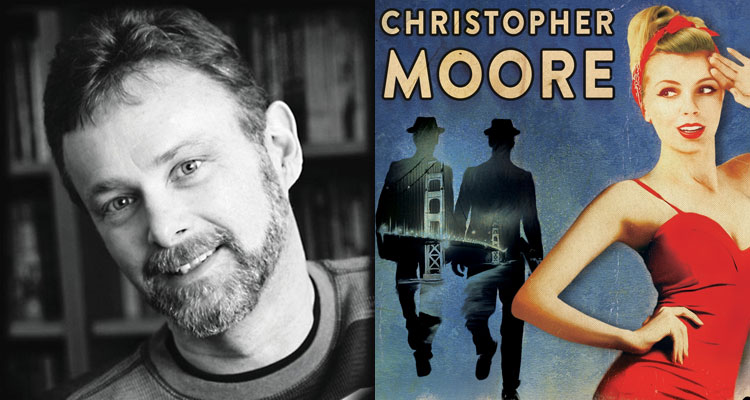In a career that stretches back more than 25 years, Christopher Moore has tackled it all. Christianity, lovelorn vampires, Shakespeare’s England, put-upon “death merchants,” and pesky demons have all populated Moore’s gonzo novels, putting the author somewhere between Tom Robbins and Douglas Adams. Moore’s latest book, Noir, travels to San Francisco circa 1947 for a hard-boiled detective/shaggy dog story where the dames are dangerous and the palookas talk like Sam Spade. It’s a genre and style that suits Moore well.
Before an appearance at Boswell Book Company Tuesday, May 2, Milwaukee Record spoke with Moore via email about his new novel, the changing demographics of post-World War II San Francisco, and Mel Tormé. (Tickets to Moore’s Boswell appearance are $30, and are available here.)
Milwaukee Record: Did you have any hesitations about tackling the hard-boiled, “a dame walks into a bar” noir genre? It seems like a genre that’s easy to imitate but tricky to do right.
Christopher Moore: Of course. Huge hesitations. At one point I couldn’t wait to start crafting hard-boiled, tough-guy metaphors, then I started doing it and I thought, “Hey, this is kind of time consuming and hard.” And you still have to keep all the balls in the air, the story, the pace, the suspense, the characters, and in the case of my books, it has to be funny as well. Sure, it was a challenge and it was harder than I’d thought, but I wasn’t completely surprised by that. I’ve written novels with specialized diction before and I knew it was going to be a challenge.
MR: Did you find any inspiration from more modern-day noirs? Maybe books and/or movies like Inherent Vice or The Big Lebowski?
CM: Actually, much more from Shane Black’s movies, Kiss, Kiss, Bang, Bang and The Nice Guys. I think he has almost the perfect balance of drama and danger in his movies, and particularly, with Kiss, Kiss, he even sort of sent up some of the standard noir tropes (like opening the movie with a guy floating face down in a swimming pool, ala Sunset Boulevard). I did read Inherent Vice as well, and some of the other forays that writers have taken into noir. (Nearly everyone tries it, it seems.) The Coen Brothers are sort of unto themselves, and while I don’t know if they influenced me specifically in this one, their willingness to just be silly for the sake of it is always inspiring. (The Scarlett Johansson character in Hail, Caesar! was just hilarious—the way she spoke would have fit right into Noir.)
MR: You’ve been living in San Francisco for more than a decade, and the city figures heavily into Noir. What about San Francisco in the mid-’40s interested you?
CM: Well, I guess it’s boring to everyone else, but the changing demographics in the city, in the whole Bay Area is fascinating to me. The fact that African American population increased about 700% because of the workers coming from the South to work in the ship yards and munitions factories. The fact that the Japanese had been sent off to internment camps and the African Americans moved into their neighborhood, so after the war, when many of the Japanese returned, there was an intersection of jazz culture and traditional Japanese culture. The fact that there were successful clubs in Chinatown where entertainers dressed up and performed as popular Anglo entertainers of the time, The Andrews Sisters, Sinatra, Mel Torme, and so on, and the clientele was mixed, but mostly catered to the upper-class whites from Pacific Heights and Nob Hill. The drag king clubs on Broadway, where women dressed and performed as men, where the crowd was both straight and gay. The soldiers were coming home from the war and needed a place to live with their families, so the Sunset, once a bunch of sand dunes, was being built into a housing track suburb in the city. The Tenderloin was going from a theater district to a place where defense workers lived in single residency hotels, but after the war was starting to toughen up and become more of the neighborhood it is today, which is to say, somewhat rough around the edges. All of it made for a great setting to have some working mugs perpetrate an adventure.
MR: You’ve mentioned that the work of longtime San Francisco newspaper columnist Herb Caen helped with the creation of Noir‘s characters. What was it about Caen’s work that you found useful?
CM: Caen wrote about the city for the Chronicle and Examiner for 60 years, with great knowledge of the people and the streets, and with great poetry. Fortunately for me, two of his collections of columns came out in 1947, so he cataloged the attitudes of the citizens toward a lot of what was going on: the cable cars tying up traffic, the jazz clubs, the niche businesses in Chinatown, the vets returned from the war and living on the street down on 3rd Street. There were several settings I would have never known about if not for Caen’s columns; one was the Chinese “jook” house (rice porridge) that was four stories tall but only 10 feet wide, where Chinese workers would duck in for a quick carb fix between long shifts—and jook houses had been around since Gold Rush. Also some of the characters. Caen wrote about a big beat cop who single-highhandedly tried to “beat the Tenderloin white” and that was the basis for one of the major characters in the book. Oh, even the location of the cat house and the aspect of the notorious madame there were based on Caen’s writing. Herb Caen was “Mr. San Francisco.”
MR: Finally, what’s next?
CM: I’m working on my third Shakespeare-based book, wherein my raucous fool, Pocket, finds himself washed up upon the shores of the world of A Midsummer Night’s Dream and is given a mystery to solve.

